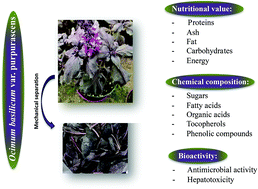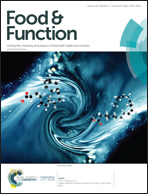Ocimum basilicum var. purpurascens leaves (red rubin basil): a source of bioactive compounds and natural pigments for the food industry
Abstract
Ocimum basilicum var. purpurascens (red rubin basil) is a basil variety rich in anthocyanin compounds, commonly used in the food industry as an aromatic plant. In this study, the nutritional and chemical compositions of red rubin basil leaves were analysed, as well as, the antimicrobial activity and hepatotoxicity of their hydroethanolic extract. Carbohydrates were the main macronutrients present, with glucose being the major free sugar. Quinic acid was the most abundant organic acid, while γ-tocopherol was the highest tocopherol isoform found. α-Linolenic acid was the major fatty acid of the twenty identified compounds. Regarding polyphenols, twenty-six molecules were identified (thirteen non-anthocyanin and thirteen anthocyanin compounds), with rosmarinic acid being the main non-anthocyanin molecule and cyanidin-3-(6,6′-di-p-coumaroyl)-sophoroside-5-glcucoside the most abundant anthocyanin. These compounds could be related to the antimicrobial activity observed in this study. Thus, this variety could be considered a good source of value added molecules for the food industry.



 Please wait while we load your content...
Please wait while we load your content...